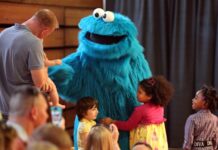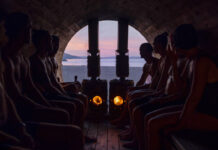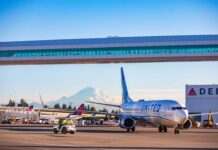What to Do in WA in November
Olympia gets a head start on winter merriment with a season-long ice skating rink.
The busy days of summer's cookouts and fall's apple picking are behind us; it's finally time to rest. The whole Pacific Northwest exhales and takes a break this month. November's festivals are calmer, celebrating artisans, chili, and tide-pool critters.
Nov 7–9 | Pasco
More than 150 artisans come together in the Tri-Cities for the annual crafts show, spread over three days in the region's convention center. Gifty-type items include jewelry, hand-thrown pottery, and nice-smelling soaps, plus vendors hawk unique holiday decor so your house doesn't look like you went to the same big-box store as everyone else on the block.
Nov 8 | Eastsound
The annual Orcas Island beer festival provides a multitude of reasons to take the ferry all the way into the San Juans for the weekend. Market Street in Eastsound becomes pedestrian-only, and more than 30 brewers set up shop alongside local bands. Though the event proper only lasts a day, local restaurants often do beer-related events in the surrounding weekend.
When it's cold outside, Camano Island has the solution: a lot of chili.
Nov 8 | Camano Island
Competitors vie for the prize for best chili (and, because this is a Salish Sea island, best chowder) in an annual event that goes back more than a quarter century. Tickets score tastes of 10 chef creations; choose wisely and you'll sample a winner. Live music and a roaring fire round out the less competitive side of the festival.
Over 5,000 spectators flock to Spokane Community College for two days of regional folk musicians.
nov 8 & 9 | spokane
Folk groups spanning Celtic, bluegrass, blues, African, Asian, and Middle Eastern traditions join forces for two days of free musical discovery in Spokane. Don't miss the commemorative festival buttons to show off your folky taste.
Biologists explain the weird world of nightswimmers at Pier Peer in Olympia.
Nov 14 | Olympia
What's under the pier? Marine biologists from Puget Sound Estuarium help decipher the sea life in a monthly nighttime event at Zittel's Marina. Sea slugs, anemones, and sea stars come out to play in this wintertime tide-pooling adventure.
Oly on Ice
Nov 21–jan 19 | olympia
Get a head start on those winter break activities with Olympia's 5,000-square-foot pop-up ice rink at Isthmus Park. Skaters of all ages glide under fairy lights and the rain-free protection of a wintery tent.
Taken by ICE
The Northwest ICE Processing Center blends into its industrial surroundings.
There is a 12-foot chain-link fence separating the Northwest ICE Processing Center in Tacoma from the world outside. But you barely notice the fence. The facility, which opened in 2004 and is operated by the for-profit GEO Group, blends naturally into its surroundings: drab and gray and low-slung. Just another warehouse in an area full of them, tucked behind the Port of Tacoma.
This is a quiet and lonesome stretch. Family members idle in their cars, waiting for visiting hours. White vans silently ferry detainees in and out of the facility. The sound of trains and nearby industrial work lingers in the background.
Among the many silent forms of protest that have taken form outside the fence—posters, altars, the occasional bouquet—a laminated sheet of paper affixed to a signpost offers a QR code linking to a GoFundMe page and the words in Spanish:
“Tomada por ICE. Apoya la batalla legal de Yeison y reúnase con su familia.”
Taken by ICE. Support Yeison’s legal battle and reunite him with his family.
At the top of the page there’s a photo of a man hugging a young girl.
Crystal-Lee Miller’s husband, Yeison Aguirre, was detained during what he thought would be a routine check-in.
Crystal-Lee Miller hung that poster earlier this year on one of her regular trips from Kennewick to visit her husband, Yeison Aguirre, in detention.
Miller would typically make the four-hour drive every other week. She would arrive in time for afternoon visiting hours, spend the night in her car a few miles away, and wake to visit him again in the morning before returning home. Sometimes she would stay two or three nights, eating sandwiches she brought from home to save money.
They met around Christmas in 2022 at a neighborhood bar in Kennewick, shortly after Aguirre landed in the United States from Colombia; they were married less than a year later, despite his not speaking much English and her not speaking much Spanish.
“We’ve got some awesome Spanglish going on,” says Miller.
“I’m putting everything I’ve got into trying to figure this paperwork out,” says Miller. “They accept it. We’re like, ‘OK, we felt semi-safe.’ And then, you know, we had new administration changes, and rules changed.”
It was a simple life. They cooked together and cared for Miller’s granddaughter Aleeyah, who lived with them (“Mi amor,” Aguirre calls her). Every night he would chat via video with his son back in Colombia, who is 8 now. On weekends, he played rec soccer. They spent time with Aguirre’s sister and her family, who lived nearby and brought him to Tri-Cities in the first place. And they did their best to prepare for his asylum hearing, which had been scheduled for 2028.
“I’m putting everything I’ve got into trying to figure this paperwork out,” says Miller. “They accept it. We’re like, ‘OK, we felt semi-safe.’ And then, you know, we had new administration changes, and rules changed.”
Since the start of the second Trump administration in January, the number of people detained by ICE across the country has approximately tripled, from 15,000 to 45,000. Less than 30 percent of those detainees have a criminal conviction. In January, there were about 700 people detained at NWIPC. Now the population is hovering near the facility’s contractual capacity of 1,575.
“We have seen a lot more people who were arrested here in this area, but we are still seeing people who have been transferred from other facilities, especially in the South where much higher numbers of people are being detained, especially along the border and in Southern cities,” says Aiden Perkinson, operations manager for the nonprofit Advocates for Immigrants in Detention Northwest.
Perkinson and his team of volunteers operate a number of programs in and around the detention center: stocking the library, showing up during visiting hours, filling up phone cards so that detainees can contact their families. But the heart of their work happens weekday afternoons in tents they have set up outside the chain-link fence and in an RV they keep nearby, where they assist detainees as they are released.
Aguirre played soccer every weekend in Tri-Cities.
There is often no rhyme or reason to when a detainee might be released. The facility is not like a jail or prison where inmates are serving fixed sentences; some stay days, some years. Many are never given a good sense of where they have been taken, either, and the government has no legal mandate to return people to where they were detained.
“We keep a map here with a little star on Tacoma because many people have no idea where they actually are,” says Perkinson.
Miller hung flyers outside the detention center leading to a GoFundMe to help Aguirre’s legal effort.
Aguirre and Miller were shopping at Walmart on a June afternoon when ICE called, asking Aguirre to come in the next morning and verify his identification. Miller was terrified. Normally Aguirre’s check-ins were with not with ICE but US Citizenship and Immigration Services. It had only been a phone call, not a legal summons, but Aguirre wanted to go. “It will be fine,” he told her.
Back in Colombia, Aguirre had worked as a carpenter building high-end advertising displays. He also volunteered as a youth counselor in his home city of Buenaventura. This made him a target in a region of the country that has been ravaged by paramilitary violence directed specifically at social leaders like him.
“I wouldn’t wish it on anybody, not even my own worst enemy,” said one detainee soon after he was released from the Tacoma facility.
He survived a kidnapping attempt that left a scar on his face and later an attack on his mother’s house. He moved frequently, ultimately landing in the capital, Bogotá, but the scar and his milky left blue eye from a childhood accident made him easily recognizable, and he was advised by Colombian authorities to flee the country—leaving his son and most of the rest of his family behind. When Aguirre landed in the United States in 2022, he turned himself over to Customs and Border Patrol at the airport and began the process of seeking asylum. Less than a month later, he met Miller.
When they showed up at the ICE office in Richland, they were greeted by a kind receptionist who guided Aguirre behind a closed door. Maybe, thought Miller, I’m overreacting. Five minutes later, an officer emerged fully decked out in tactical gear to let Miller know that her husband was being detained.
She held it together. She promised to not make a scene. She is grateful the officer at least let her come say goodbye.
Since it started counting in 2019, AIDNW estimates it has helped somewhere between 6,000 and 8,000 detainees. But one of the ironic challenges it faces right now is that much of the work it does at the welcome center requires ICE to actually release people. You can’t welcome folks who are still inside those gray walls, can’t give them rides to the airport or new clothes or gift cards for meals.
The facility itself is something of a mystery to outsiders: Owned by the federal government, operated by the largest private prison company in the United States, it exists beyond the authority of local regulatory agencies. And the federal regulatory bodies that do have access have been neutered by the Trump administration.
In 2023, Washington state passed a law that would mandate certain conditions inside and allow its agencies access for inspections. But the implementation of that law is currently held up in court. Meanwhile, detainees are dealing with substandard food and insufficient medical care.
Aguirre says he has experienced both. He was served a large piece of glass in his food during one meal. And soon after he arrived in June, he injured his foot playing soccer in the yard. An X-ray revealed that it was broken, but in the months afterward, he received no follow-up treatment as it remained swollen: just a bandage, a boot, and a set of crutches.
Aguirre injured his ankle in the yard but was never able to see a specialist.
“There’s a big old mountain shape where you can see the bone poking, pushing up against the skin,” says Miller. “He asked to see a doctor, asked to see a doctor. ‘Oh sorry, there’s no doctor available, there’s no doctor available.’”
Aguirre had been found at fault for a misdemeanor single-car accident the year before. But it turned out this was not the reason for his detention. Rather, it had to do with his asylum case, says Miller.
An immigration court judge in Tacoma set Aguirre up with a new asylum hearing, but their attorney no-showed the initial court date, and they didn’t have money for a new lawyer. (There are no government-appointed attorneys in immigration court.) The judge advised them to take a different path: Asylum would likely be granted only if Aguirre was fleeing from the threat of government violence, not paramilitary or narco violence, which was what he faced. And if he lost his asylum hearing, he would face a 10-year ban on reentering the United States.
This is far more than Aguirre was able to bring with him when he was detained in June.
The other path would be for Aguirre to voluntarily self-deport and pursue legal resident status through his marriage to Miller. The couple had begun that process immediately after their wedding in December 2023 by filing an I-130 form and uploading evidence of their relationship regularly to a government portal: lease paperwork, bills, family photos. But there was no indication that their application would be approved anytime soon.
On a recent afternoon, a detainee hobbled out from behind the chain-link fence on crutches and made his way over to the AIDNW tents. “I wouldn’t wish it on anybody, not even my own worst enemy,” he said in Spanish. But it wasn’t Aguirre.
This detainee had been arrested in Portland during what he thought would be a routine check-in and released following a successful appeal by his attorney. The ankle shackles used when he was detained had reaggravated an old injury—hence the crutches.
He sat under a tent and drank a Sprite, and then a Coke. He transferred his belongings from the clear garbage bag he had been given into a backpack provided by an AIDNW volunteer (he declined the offer of new clothes). On his wrist, he wore an identification bracelet he had been given inside. As he waited for his wife to make the drive up from Portland with their baby daughter, white vans marked with the words GEO Group continued to pass in and out of the parking lot. One of them would soon hold Yeison Aguirre.
After debating the risk of an asylum hearing, Aguirre elected to self-deport and accept a flight back to Colombia from ICE. “I’m scared to go back to Colombia,” Aguirre said. But at the very least, he would get to see his son.
His hope—and Miller’s—was that with help from US Sen. Maria Cantwell’s office their I-130 would be processed quickly and Aguirre would either be released from custody before he was officially deported or be able return to the United States quickly, and bring his son.
In early October, Miller learned that Aguirre had been flown to a facility in Arizona, then to Louisiana. Each destination farther from their life in Kennewick. On a phone call from the ICE Processing Center in Louisiana, Aguirre said he understood that his situation was a political one, not a reflection of the country that has detained him. “It doesn’t have anything to do with the people.”
Miller and Aguirre hope that their I-130 application might be expedited so he can return home soon.
Neither he nor Miller knew when exactly he would be deported or when he would return. Miller was unable to get his belongings to him, unable to make one final visit in Tacoma or anywhere else.
“He’s going to be dropped off in Bogotá, Colombia, with the clothes he has on his back,” she said, noting he was detained in June, so he didn’t have a coat. “He has a broken foot, and they won’t even let him keep the crutches.”
A week later, with only his passport in hand, Aguirre boarded a flight for Colombia.
Where to Sauna in Seattle
Bywater Sauna's parking spot is right next to the Puget Sound cold plunge.
Get hot, get cold, repeat. No, it's not the yo-yo weather patterns of a Washington winter or the shorthand for an unhealthy relationship; that's the rhythm of sauna culture. It's a leisure activity that takes you from a room hotter than Phoenix in July to waters exactly as cold as Puget Sound in January.
And Seattle is in a sauna boom. The practice has roots that trace back to Nordic traditions, where enjoying a sauna is as common as taking a walk, and to the social Roman baths of the ancient era. This year, the National Nordic Museum is hosting the first Seattle Sauna Festival to celebrate sauna-going, but all the destinations below operate regularly for one-off warm ups.
The Bywater Sauna has two wood fireplaces so warm a cold plunge comes as a relief.
West Seattle, Ballard
Passersby do double takes at these barrel-shaped saunas parked at Golden Gardens or Alki beaches, like a pair of giant Twix bars with two little chimneys poking out of each. For all the indoor heat Nate Garberich offers with his traveling setup, it was inspired by the very frigid: The idea largely grew out of cold plunge group Coldwater Collective. Each Minnesota-built structure holds 16 people who alternate between extreme temps. Admission is available via a one-time $35–40 pass or a monthly membership.
The shape of the Bywater saunas is conducive to even a full house, creating a social but never a sardine-can situation. The twin wood fires make one end especially scorching, for sauna experts, but the door side is usually milder. Sure, users get stares when they climb out in a bathing suit and run to the lapping Puget Sound waves, but on one cold plunge at Golden Gardens we got to share our swim with a giant, curious sea lion.
The Seattle Bouldering Project's new bank vault sauna has warmth on lock.
University District
When the rock climbing chain opened its University of Washington–adjacent outpost in a 112-year-old bank building, there was an obvious use for the giant vault: a co-ed sauna. An infrared version was chosen for many reasons, from necessity (there are limitations on what you can put in a closed room lined with safety deposit boxes) to infrared's associations with muscle healing. The benches can hold 26 people and the yoga team sometimes does breath programming in the space. Glass walls stay open to the circular vault door, so it's nowhere near as claustrophobic as it sounds. Day passes ($30) for the climbing gym include sauna access.
After only one season, Von Sauna in Kirkland added a second floating hot room.
Kirkland
Inspired by the floating saunas of Oslo, Norway, David Jones designed his own barge setup and had it constructed in Louisiana (the barge part) and Michigan (the wood room). Once delivered to Seattle, he moved them across Lake Washington by towing them with a jetski, finally tying up at Carillon Point Marina in Kirkland.
Open since January 2024 (but closed June–September), Von has grown to two saunas with 18 bookable seats ($32–40 each) between them, the big glass windows looking out at the sailboats and yachts anchored across the water. The cold plunge roulette includes a ladder down to the lake, a bucket on a string for self-dousing, and a small beach in front of the nearby Woodmark Hotel for gentle wading. The space can't compete with the Pacific Northwest's most stunning floating sauna, in Tofino, but the on-water location adds a pleasant bobbing sensation to a sweat session.
Wild Haus goes places—to the middle of the lake, at least.
Eastlake
The greater Seattle area went from no floating saunas to a veritable armada in only a few years. Of the two businesses that now operate on Lake Union, Wild Haus offers the most adventurous—its little barge actually travels into the center of the lake, driven by a captain on the 90-minute communal tours. That means the view from the hot room changes as the wall of windows faces various skylines, and cold plunges can be done into the lake itself.
Private voyages (starting at $900) allow groups to take over the whole vessel, but even the à la carte trips ($150) have social energy; this is no solemn, whispers-only sauna. A rooftop deck, next to where the wood-fired chimney pokes out of the room below, allows for outdoor hangouts between hot and cold periods.
Joggers pass Good Day Sauna on one side, while ferries pass on the other.
West Seattle
The boxy mobile sauna positioned in Lincoln Park has a big window to take in the views of the cold water—aka the plunge destination—outside; sometimes a ferry headed to nearby Fauntleroy Ferry Terminal makes a cameo. Like its neighbor Bywater at Alki, it's a wood-fired sauna that holds over a dozen people at a time.
Opened this summer, this will be its first winter in the park, and will mostly do weekend social sauna sessions ($35 for an hour). Occasional guided meditation sessions add another layer to the experience, where a group does breath work and group relaxation over the course of 75 minutes ($55).
Northlake
Yet another floating hot room on Lake Union; pretty soon they're going to outnumber the paddleboards. The difference at Seattle Sauna comes in the big rooftop deck for relaxation and a guide to walk everyone through how to get the most out of the experience. Though the sauna, fueled by two wood fires, does bob on the water's surface, it doesn't travel out into the lake during each 90-minute session ($64). With only 10 users per session, it's not one to get crowded, and bucket showers serve as cold plunge. Aromatherapy, plus the basics like a towel and drinking water, is included.
What It’s Like to Truly Be Sleepless in Seattle
When Naomi Mittet gave birth to her first and only child, her sleep went topsy-turvy. The West Seattle resident didn’t think much of it at first—after all, infants aren’t exactly known for their reliability in blissfully snoozing through the night—but as her baby turned into a toddler and still was sleeping at all different times, she started to wonder what might be going on. She’d worked in early childhood education and always been able to get little ones to nap. Why wasn’t it working with her own offspring?
School days were rough. Mittet’s child might go to school on only a few hours of sleep or have to stay home and rest. Their mental health was suffering, and school administrators didn’t understand. “They just thought I was either not trying hard enough or that maybe my kid was lazy, or they thought it was related to anxiety,” she says. “I would actually call it traumatic. It became a life-or-death situation for my kid and it was terrifying not knowing what was going on.”
Mittet, now 56, threw herself into research, and when her child was 12, she finally cracked the code: non-24-hour sleep-wake phase disorder.
Non-24, as it’s known, is a circadian rhythm sleep disorder, part of a family of conditions where someone’s sleep-wake cycle is disrupted. These disruptions are caused by the body’s internal clock not being synced to the sun or social time. Many people have experienced this feeling temporarily when traveling across time zones, but some people have something akin to jet lag all the time.
It’s related to our chronotype, which is about 50 percent determined by our biology. “All of us are born genetically with a predisposition to a very specific chronotype, meaning the time of the day when we prefer to be asleep and when we’re most cognitively alert,” says Seattle-based neuropsychiatrist Lina Fine, MD. In general, there are early birds, intermediates, and night owls. Anyone who’s on the far end of the spectrum one way or another—or doesn’t align with the spectrum at all—could be at risk for a circadian rhythm sleep disorder.
“I would actually call it traumatic. It became a life-or-death situation for my kid and it was terrifying not knowing what was going on.” —Naomi Mittet
While these disorders are thought to be fairly rare, they’re also widely considered to be underdiagnosed, so it’s tough to put an accurate number on it. Current estimates say 3 percent of people worldwide are affected.
A circadian rhythm disorder differs from a sleep disorder like insomnia or restless legs syndrome in that the quality or quantity of sleep is not typically affected when a person is able to sleep according to their preferred schedule—it’s all about the timing of that sleep.
Non-24 is the rarest circadian rhythm sleep disorder, and like the name implies, it happens when someone’s internal clock is not running on a typical 24-hourish cycle. While most of us have an internal clock that’s not exactly 24 hours—the average is actually about 24 hours and 11 minutes—people with non-24 might have a 25- or 26-hour clock. This means they get sleepy and wake up at a different time every day, often about an hour later than the day before. (While some people with non-24 have clocks shorter than 24 hours, this is not as common.) An estimated 50 percent of people who are completely blind have non-24, but it also happens in sighted people.
That’s the case for Mittet’s child, who was diagnosed after two weeks of wearing an actigraphy device, which monitors sleep-wake cycles. Although it’s not an easy condition to treat, the diagnosis made a huge difference. Mittet started homeschooling so that her child could free-run, or follow their own natural rhythm. This means that they go all the way around the clock, which takes approximately a month—so if they go to bed at midnight tonight, bedtime might be somewhere around noon in two weeks. Being allowed to free-run quickly improved their health, erasing symptoms of sleep apnea and asthma that had previously been present.
Doing things like scheduling appointments in advance or working a job with set hours is challenging for those with non-24. “It’s very debilitating,” Mittet says. “There’s a lot of isolation, and for the caregivers, there’s a lot of stress and guilt. I do not know how my kid did it. They said most of their energy at school throughout the years was on just trying to keep themselves awake. And that just breaks my heart, because I had no idea.”
Even in a milder form, circadian rhythm disorders can be disruptive. Loyal Heights resident Tyler Zuck, 40, considers himself a night owl—he likes stargazing more than high noon—but he also enjoys a sunrise. When he was in college, he tried to transform himself into a morning person by taking a swim class at 7am and a math class at 8am. He’d always heard the advice that if he just stuck to the habit long enough, he’d develop the discipline to get up early with ease. That did not happen. “I got so depressed, I just about flunked the semester and didn’t go back the next year,” he says.
Although Zuck was pretty good at functioning on very little rest—a trait he thinks he inherited from his dad, an ER doctor—as he got older, it became more difficult. He started to realize that something wasn’t right with his sleep and it was seriously affecting his mental health. He was diagnosed with sleep apnea, but that made no difference. By chance, he stumbled on some information about delayed sleep-wake phase disorder, the most common of the circadian rhythm disorders. This is when someone tends to fall asleep and wake up later than conventional hours.
“I went, ‘Oh my goodness,’” he remembers. “It was that moment in your life when you realize a whole bunch of stuff is connected.”
Zuck found a sleep specialist in the area who had circadian rhythm disorders listed on his website. After Zuck wore a diode ring on his head for six nights to read his brainwaves, the doctor was able to determine that he was not getting REM sleep until very late in his sleep cycle, if at all.
For people with non-24, it can feel like you're constantly traveling across time zones.
Zuck’s doctor encouraged him to try waking up at 2pm to see how it felt. He was skeptical, but he tried it out—and was blown away by the results. “I didn’t know you were supposed to wake up like that, not wanting to be in bed,” he says. “The shocking feeling to me was ‘I don’t want to be in bed anymore; I’m done here.’ I’d never experienced that before.”
Today, Zuck is a full-time stay-at-home parent, and while his responsibilities mean he can’t wake up at his body’s preferred time of 2pm, he’s generally able to sleep until 10am all but one or two days a week. He uses light therapy glasses to help shift his clock and has found a sustainable routine. But the thing about circadian rhythms is they like to shift back to baseline. “My doctor warned me that it would be like pulling on a rubber band—the further I got from my natural spot, the harder it would be to pull on it, and if I ever stopped light therapy, I would snap back,” he says. That has been accurate—three or four days without the glasses or with a disrupted schedule sends him right back to his starting point.
Living with delayed-sleep-wake-phase disorder is challenging, but it hasn’t been all bad. “When my kids were infants, it was a superpower,” he says. “I basically could stay up late and there was always an awake parent with the baby.”
Dr. Fine says treating circadian rhythm disorders isn’t easy, but it’s often doable. “It is something that can be gently manipulated, slowly over the course of time, if an individual is able to stick to gradual schedule adjustments,” she says. Harnessing light and darkness to your advantage is one of the most effective strategies, and some people have success with melatonin supplementation. But it’s still hard work, especially given that people tend to gravitate toward their natural sleep patterns.
The early nights and overcast days of Seattle winters don’t typically make much of a difference either. “People think in Seattle, we don’t get any light, but even the overcast, low light between the rains is still pretty good,” says Dr. Fine. (This is in reference to getting sunlight at the right times to help sync your clock. The sun is still way more powerful than indoor lighting, even on a very gray day. With something like non-24, though, you're not going to be able to change your schedule with sunlight, although it might help you feel a little better.)
If you’re fatigued during the day despite getting seven or eight hours of sleep at night, that could be a sign that your sleep isn’t restorative.
If you’re having an issue sleeping, how do you know if it merits further investigation? “On some level, you have to trust yourself because subjective perception can be more important than objective trackers,” Dr. Fine says. If you’re fatigued during the day despite getting seven or eight hours of sleep at night, that could be a sign that your sleep isn’t restorative. Excessive broken or fragmented sleep and trouble falling asleep can also signal trouble.
“It starts as a circadian phenomenon, but it ends as a psychological one because, for lots of people, it becomes sleep-related anxiety,” Dr. Fine says. Even many sleep doctors aren’t well versed in circadian issues, so it helps to find one who is. The nonprofit Circadian Sleep Disorders Network, which Mittet has served on the board of, maintains a database of specialists who patients have reported are knowledgeable in this area.
Each person has to find what works for them. While some might want to try to sync to sun time as closely as possible, others may want support in structuring their life to accommodate their circadian rhythms. Often it’s a combination of both.
“If somebody gets diagnosed, maybe they’re not going to find a treatment for it, but they can at least have support and understanding,” says Mittet, who herself identifies as a delayed sleeper. “More compassion and even just belief that the condition exists would just make such a huge difference for people who have circadian rhythm sleep disorders.”
This Is the Spookiest Lake in Washington
The spookiness of Soap Lake extends to both the physical and spiritual realms.
October is spooky for a reason. The days grow shorter, the nights longer, and hints of death are everywhere—subtly, in the leaves falling from trees and gardens going dormant; sensationally, in candy wrappers printed with tombstones and skulls.
It is also Spooky Lake Month, a celebration of “haunted hydrology” that began in 2020 when TikTok megastar, Geodesaurus (Geo Rutherford), began sharing her passion for weird bodies of water. Rutherford and other spooky lake enthusiasts typically focus on catastrophes, such as shipwrecks, diving disasters, and all manner of wet death.
We have our own share of spooky waters here in the Pacific Northwest. Most notably is probably Lake Crescent, where in 1940, a murdered woman’s body turned into soap after spending a few years in its depths. But in my mind, none are as spooky as Soap Lake, a mineral lake scooped out of the sagebrush and basalt of Eastern Washington.
Nobody has actually turned to soap in its waters, but in Soap Lake, science has echoes of science fiction, and the natural has echoes of the supernatural.
One of its strangest qualities is sometimes called the “lake within the lake”—or monimolimnion—which is a body of water within this body of water, like a hydrological hall of mirrors. Most lakes turn over throughout the year, so the water on the bottom cycles to the top, and vice versa. But Soap Lake is stratified, with a natural “chemocline” barrier that keeps the two layers separate. For millennia, the water deep down has been trapped and untouched. It’s three to five times saltier than seawater, has no oxygen, and is the consistency of syrup or goo. And with a natural dash of arsenic (five times the amount that is safe to swim in), as well as high concentrations of sulfur, you wouldn’t want to drink it.
But that’s all down deep, and the top layer of the lake is perfectly fine for swimming and wading. Some people even drink it. Every day.
For a long time there was a spigot on Main Street in the town of Soap Lake that flowed straight from the lake, and it wasn’t uncommon to see people loading containers with water to take home for drinking and bathing, and to make soaps, lotions, and maybe even potions.
This is because Soap Lake also has a long history of healing.
The lake was thought to have healing properties. Turns out that arsenic might have played a role.
Taking a cool swim in the silky waters of Soap Lake—looking up the coulee at the basalt cliffs, with hardly any civilization in sight—it’s hard not to think about all the people who have suffered here, and all the relief these waters have brought.
For centuries, people have made pilgrimages to this unusual lake. Indigenous people of the Columbia Plateau soaked in its waters for spiritual and physical healing. Around the turn of the last century, white settlers followed their lead, even soaking their livestock in the lake to get rid of parasites. (Dr. Leo Bodensteiner, emeritus professor of ecology at WWU, theorizes that the aforementioned arsenic might have played a role in exterminating all those ticks and fleas…)
With its sunny climate and reputation for healing, Soap Lake soon became the most popular resort town in our state. Its spa hotels and vacation cottages were packed with visitors. Postcards and packaging with spiritual vibes announced, “It Will Cure You!” and called the lake, “God’s Gift to the Sick!”
Perhaps the most fascinating aspect of this boom-time was the arrival of veterans, and the realization that all this woo-woo talk of healing wasn’t so woo-woo: The lake really worked.
After WWI, returning soldiers who suffered from Buerger’s Disease found little relief in Western medicine. This circulatory affliction was excruciating and horrific, causing flesh to erode and expose the nerves. Some of its victims—“half-insane from pain, maimed, hopeless,” according to a 1937 American Legion Monthly article—endured so many amputations they were said to be dying “an inch at a time.”
And this remote little lake in the heart of our state cured them.
Cured them.
The treatment itself—soaking in Soap Lake—was unbearably painful, but over time, it healed their dying flesh. In 1938, the Veterans Administration found enough evidence of the lake’s healing properties that it built a hospital in town to help these people on their journey.
Eventually, with broader access to antibiotics and the onset of interstate travel, visitors decreased and, like many rural places in the Inland Northwest, the town went into decline. In the early 2000’s, when a BBC report said Soap Lake was “well on its way to becoming a ghost town,” it was best known for Brent Blake’s quest to build the World’s Largest Lava Lamp as a way to renew the local economy and return attention to the ecological gem of the lake. It’s a project that many of us found well-suited for this colorful place.
Spookiness often centers on the unknown—the monster behind the door is typically creepier than the monster we can see—which might explain our fascination with spooky lakes. Amniotic origins aside, the depths of a body of water are not only obscured beneath the surface, behind the proverbial door, but also remind us that we can’t breathe down there. That’s scary. Besides, do we ever feel more vulnerable than while floating in water and feeling something unknown graze the bottom of our feet?
Soap Lake, more than most lakes, feels like a manifestation of that unknown.
“This water isn’t water,” says a character in my novel, Midnight in Soap Lake, who has recently moved to a fictional version of the town to study the “miracle microbes” discovered in the lake. It’s a creepy mystery novel, so of course things don’t go so well.
Perhaps the spookiest aspect of Soap Lake is more real than mythical or fictional: This rare mineral lake is slowly dying. It is being diluted by groundwater, and “the lake within the lake” is shrinking significantly. There are many potential reasons for this, including climate change, but it is mostly due to the impact of irrigation in the region.
The Columbia Basin Irrigation Project carries nearly a trillion gallons of water each year from the Columbia River through a network of canals to 670,000 acres of farmland. But since the 1950s, despite the addition of intercept wells, groundwater from the canals has seeped into the lake, “freshening” it and diluting the very qualities that make it unique.
Irrigation is slowly draining Soap Lake. But there's not much we can do to save it. Perhaps that's the spookiest fact of all.
In 2023, the Washington Department of Ecology listed the negative impact of irrigation as one of the reasons for designating Soap Lake an “Outstanding Resource Water.”
Earlier this year, when I asked Dr. Bodensteiner, one of the authors of the irrigation study, whether he was optimistic about the future of Soap Lake, he said, “I’m realistic.”
Meaning: Agriculture in the region is a multibillion dollar industry, and there isn’t any immediate solution to a problem of this scope. It goes without saying that no one is planning to shut down the canals in order to help save a lake, regardless of its ecological, cultural, and historical importance—and no matter how spooky it might be.
That reality might be the most unsettling thing of all.
Every Nonstop Flight from Seattle’s Sea-Tac Airport and More
Flights depart Seattle for spots around the globe, no layover required.
Forget Making connections. Seattle's airports have direct flights to more than a hundred destinations, served by more than 30 airlines. Travel as close as San Juan Island (35 minutes of scenic cruising) or as far-off as Singapore (more than 16 hours in an airliner) and never suffer the indignity of a layover.
We catalogued all the direct flights from Seattle-Tacoma International Airport (otherwise known as SEA), plus our other, smaller runways. Note that some flights are seasonal, and as is always the case with an international hub, the flight maps (like Sea-Tac's domestic and international ones) are ever-evolving. We're including new routes that have been announced even if they haven't yet begun, as long as tickets are already for sale.
Before your flight, make sure you snag a spot to skip the security line. Bon voyage!
From Sea-Tac: Pacific Northwest | California and Southwest | Mountain West | Midwest and Texas | South | Mid-Atlantic and New England | Alaska and Hawai'i
International: Canada | Mexico and Central America | Europe | Asia and South Pacific
Other Airports: Paine Field | Boeing Field | Float Planes
Domestic Nonstop Flights from Sea-Tac Airport
Pacific Northwest
BellinghamYakimaWenatcheePullmanPasco/Tri-CitiesWalla WallaSpokanePortlandEugeneMedfordBend-RedmondSun ValleyBoiseIdaho Falls
California and Southwest
ReddingArcata-EurekaRenoSonoma CountySacramentoOaklandSan FranciscoMontereySan JoseFresnoSan Luis ObispoSanta BarbaraLos AngelesOntarioBurbankOrange CountySan DiegoPalm SpringsLas VegasPhoenixTucsonAlbuquerque
Mountain West
DenverYampa Valley (Steamboat Springs)Eagle County (Vail)BozemanKalispellMissoulaHelenaGreat FallsBillingsJacksonSalt Lake City
Midwest and Texas
OmahaKansas CityWichitaOklahoma CityTulsaEl PasoDallas Fort WorthDallas Love FieldAustin San AntonioHoustonSt. LouisMinneapolisMadisonMilwaukeeChicago O'HareChicago MidwayIndianapolisDetroitColumbusCincinnatiCleveland
South
New OrleansNashvilleTampaFort MyersMiamiFort LauderdaleOrlandoCharlestonAtlantaRaleigh-DurhamCharlotte
Mid-Atlantic and New England
Washington DullesWashington ReaganBaltimorePittsburghPhiladelphiaNewarkNew York John F. KennedyBoston
Alaska and Hawai'i
FairbanksAnchorageJuneauSitkaKetchikanLihue, KauaiHonolulu, OahuKahului, MauiKona, Hawai'i
Flight EnvyWhile Seattle has around twice as many direct routes as Portland's PDX, there are four airports it services that Seattle doesn't: Pendleton, OR; Santa Maria, CA; Des Moines, IA; and Grand Rapids, MI.
International Nonstop Flights from Sea-Tac Airport
Canada
Calgary, CanadaEdmonton, CanadaKelowna, CanadaMontreal, CanadaToronto, CanadaVancouver, CanadaVictoria, Canada
Mexico, Central America & the Caribbean
Belize City, BelizeLiberia, Costa RicaCancun, MexicoGuadalajara, MexicoLos Cabos, MexicoMexico City, MexicoPuerto Vallarta, MexicoNassau, Bahamas
Europe
Amsterdam, NetherlandsDublin, IrelandFrankfurt, GermanyMunich, GermanyZürich, Switzerland Copenhagen, DenmarkHelsinki, FinlandIstanbul, TurkeyLondon, EnglandParis, FranceBarcelona, SpainReykjavík, Iceland
Asia and South Pacific
Doha, QatarDubai, UAEPapeete, TahitiManila, PhilippinesSeoul, KoreaShanghai, ChinaBeijing, ChinaChongqing, ChinaHong KongSingaporeTaipei, TaiwanTokyo Haneda, JapanTokyo Narita, Japan
Border BoundThe YVR airport in Vancouver, BC, offers plenty of Canadian nonstops (Saskatoon, anyone?), plus novel international destinations like New Delhi, India; Auckland, New Zealand; and Sydney, Australia.
Paine Field is as chill as Sea-Tac is crowded.
Nonstop Flights from Paine Field
San FranciscoLos AngelesPalm SpringsOrange CountySan DiegoLas VegasPhoenixDenverHonolulu
Nonstop Flights from Boeing Field
Portland, OregonFriday Harbor, San Juan IslandEastsound, Orcas Island
Future FlightAmerican Airlines has dangled the possibility of a direct route from Seattle to Bengaluru (Bangalore), India, since 2020, but its launch has been delayed several times.
Nonstop Float Plane Flights from Lake Union and Lake Washington
Friday Harbor, San Juan IslandRoche Harbor, San Juan IslandWest Sound, Orcas IslandDeer Harbor, Orcas IslandFisherman's Bay, Lopez IslandVictoria, CanadaVancouver, Canada (via Harbour Air)
What Does $5 Buy You at Seattle’s Best New Restaurants?
Hungry for news? Welcome to our Friday Feed, where we run through all the local food and restaurant news this week—and maybe help you figure out where to eat this weekend.
Small Price, Big Deal
Sticker shock struck often for Seattleites out to eat this year, so when we named our Best New Restaurants of 2025, we also scanned the menus to find a few good things that $5 still buys.
Douglas Lager, $2
My Friend Derek's
The folks behind the erstwhile Lowercase Brewing designed Douglas as an easy-to-drink, low-cost, still-local alternative to Rainier—and at this price, it makes a compelling argument for eating in rather than taking out.
Bialy, $4.50
Hey Bagel
Hey Bagel clearly sees the value of these undersung cousins of the bagel, rotating the classic onion flavor with modern ones like pepperoni and cheese pizza.
Bowl of Rice with Butter and Furikake, $3
The Wayland Mill
Hot rice with butter is one of the most comforting foods in the world, and this version even gussies it up with a sprinkle of seaweed seasoning.
Openings and Closings
Chapter one: Just in time for cozy season, Ballard got a new book-themed bar called the Ink Drinker. Opening today, it advertises no TVs, no distractions, just a bunch of cocktails inspired by Sapphic literature.
Melting away: Local small-batch scoop shop Sweet Alchemy announced that it will be closing its Ballard location as of November 1. The other three locations (Capitol Hill, U-District, and Bellevue) remain operating normally, and Ballardites can still pick up pints from nearby Salmonberry Green Grocer.
Now churning: The laws of the dessert-iverse demand that when one ice cream shop closes… a Salt & Straw must open. The Portland-based chain will open its sixth Seattle space in Pike Place Market on November 7, and, of course, will have an appropriately themed flavor: the Pike Sundae, which involves horseradish gelato and smoked salmon “snow.”
Camera ready: The Salt Bae meets Criss Angel at the new upscale halal chain arriving this weekend in South Lake Union. Meat Moot’s own advertising reminds diners to have their phones ready to record; there are lots of knives being thrown around in their Instagram videos. Dubiously, the Turkish chain claims to be the city’s first wood-smoked meat destination. (Many barbecue restaurants likely have questions about that.)
Spaces filling up: Joining the canon of places seemingly named to avoid being found on the internet, a cocktail lounge called Spaces Available will open in Pioneer Square early next year, reports the Puget Sound Business Journal. The bar joins a slew of openings hitting the area soon: a trio of Renee Erickson restaurants coming to nearby RailSpur, along with New York cocktail bar Death & Co., Asadero Prime sibling Gordo Steak, and a location of mega-pub Tom’s Watch Bar.
Oh, BTW, here’s what you missed last time.
Varsity Benched, Little Red Hen Quieted, and More Food News
Middle Eastern cafés come in hot this week.
Seafair’s Ridiculous New Event Is All About Imagination
Can You Ride It? Saturday's competition is exactly what it says it is.
What to Do in Washington in August
There's lots of summer left at a UFO event and a floating music festival.

























